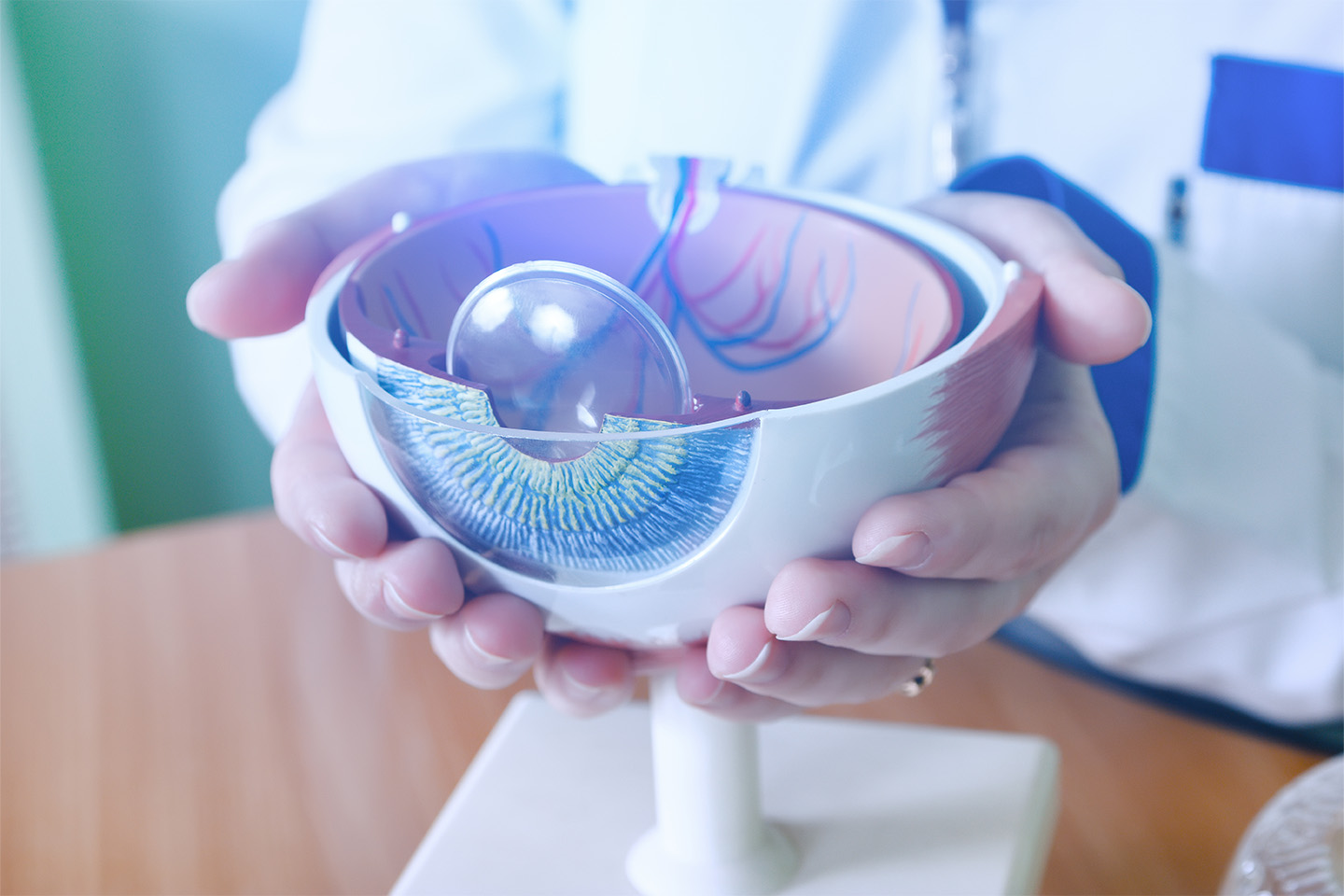How Long Should You Wait Between Cataract Surgery on Each Eye?

Cataract surgery is one of the most common and highly effective outpatient procedures that can significantly improve vision and quality of life for individuals with cataracts. But individuals with cataracts in both eyes may be curious about the optimal timing between surgeries and wonder whether a second eye surgery would be better than same-day treatment for both eyes. Here’s what you should know about bilateral cataract surgery and how the timing of operations may impact cataract surgery recovery.
Understanding Cataract Development
Each eye has a natural lens positioned behind the iris, which is the colored portion of the eye. The lens, comprised of proteins and water, focuses light to create a clear image on the retina. Around the age of 40, the proteins break down and form a cloudy area on your lens — the cataract.
Like many eye conditions, cataracts typically develop slowly and may not show noticeable symptoms for decades. Regular eye exams play a vital role in preserving clear vision and preventing the progression of cataracts. Cataracts are particularly common among older adults, making regular eye exams crucial for early detection and treatment. Without treatment, cataracts can eventually lead to vision loss. However, cataract surgery can reverse this condition and restore your vision.
What Happens During Cataract Surgery
During cataract surgery, the surgeon replaces the clouded lens with an artificial lens, also known as an intraocular lens (IOL), made of silicone, acrylic, or plastic. The procedure uses local anesthesia and often takes no longer than 20 minutes. Most surgeries use the phacoemulsification technique, during which the eye surgeon creates a microscopic incision using a blade (traditional cataract surgery) or laser (laser-assisted cataract surgery) to remove the cataract. This procedure eliminates the need for sutures or patches after the surgery.
Patients will be prescribed eye drops to use after the surgery to aid in the healing process and prevent infection. When cataracts are present in both eyes, surgery is typically performed on one eye at a time in separate operative settings, under the guidance of an eye doctor, to allow for healing. Performing these procedures with a specific interval of time between each is known as delayed sequential bilateral cataract surgery (DSBCS).
The Benefits of DSBCS
DSBCS is the standard practice for bilateral cataract removal in the United States. Immediate sequential bilateral cataract surgery (ISBCS), which is eye surgery performed on both eyes simultaneously in the same procedure, may be recommended in some rare circumstances. However, further research is needed to determine its safety and refractive outcomes. In many cases, cataract surgery can reduce or eliminate the need for glasses or contact lenses, further enhancing the patient’s quality of life.
DSBCS is typically scheduled one to three weeks apart and offers benefits that can support improved outcomes while mitigating the risk of complications:
- Time to assess side effects, refractive correction, and IOL type. The surgeon can adjust the refractive target or recommend a different IOL to optimize the vision outcome of the second eye after considering the patient’s experience, side effects, and feedback from the first surgery.
- Adjustment period for healing and vision improvement. Adapting to a new IOL takes time, and having a few weeks between surgeries allows the eye to heal and your brain to adjust to the visual changes more comfortably.
- Reduced disruption to daily life. Having one eye that is fully functional while the other eye is healing can minimize disruptions to daily life activities and allow for increased independence. This approach allows patients to return to their normal activities more quickly, as they can rely on one fully functional eye while the other heals.
By allowing time between procedures, DSBCS offers a safer and more personalized approach to vision correction. Patients often appreciate the ability to adjust and recover at a comfortable pace. While same-day surgery may sound appealing, most individuals benefit from the flexibility and improved outcomes that come with a staged treatment plan that includes proper post-operative care.
Risks and Benefits of Waiting vs. Immediate Second Eye Surgery
When planning cataract surgery on both eyes, many patients wonder whether it’s better to have both done on the same day or wait between procedures. While immediate sequential bilateral cataract surgery (ISBCS) may sound convenient, it’s not the standard approach in the U.S.—and for good reason.
Benefits of waiting (DSBCS):
- Allows your surgeon to assess your healing and vision outcome from the first surgery
- Provides time to fine-tune the intraocular lens (IOL) choice or refractive target for the second eye
- Reduces the risk of rare but serious complications, such as infection affecting both eyes
- Gives your brain time to adjust to the new vision in stages, which may feel more comfortable
Potential drawbacks of waiting:
- Some patients may feel imbalanced between surgeries due to having one eye corrected and the other not
- Requires two separate recovery periods and appointments
In certain cases—such as for patients with limited mobility or travel challenges—ISBCS might be considered. However, for most individuals, delayed sequential surgery offers more flexibility and a safer path to optimal results, reducing the risk of secondary cataract.
How to Prepare for Your Second Cataract Surgery
Your second cataract surgery will likely feel more familiar and less stressful than the first—but preparation is still key to a smooth recovery. Once your doctor confirms your first eye has completely healed, they’ll schedule the second procedure, often within two to three weeks. Adjusting to the new lens in your eye can take some time, so it’s important to follow your doctor’s instructions carefully.
To get ready:
- Review your experience from the first surgery—note what worked well and where you had discomfort or questions.
- Continue using any prescribed drops for the first eye as directed, following the instructions for the upcoming procedure.
- Arrange transportation again, since you won’t be able to drive home afterward.
- Set up your recovery space in advance—having clean linens, eye protection, and easy access to medications helps.
- Ask your doctor about any adjustments based on your response to the first surgery (e.g., drop schedules, IOL options).
- Ensure you have an eye shield to protect your eye during the initial recovery period.
Approaching the second procedure with insight from the first often leads to a more confident experience and just as successful results.
Trust Colorado’s Cataract Experts
The exact duration of time between surgeries can vary based on different factors. The surgical technique and the patient’s overall health (including age, preexisting health conditions, and the ability to heal and follow postoperative care instructions) significantly influence the time interval between surgeries.
At ICON Eyecare, we prioritize your safety and the quality outcome you deserve. We provide a seamless experience by planning both eye surgeries simultaneously and scheduling them two weeks apart. Our goal is to achieve a specific visual outcome that meets your individual needs and ensures the best possible vision.
We remain by your side throughout your cataract surgery journey and will adjust your treatment based on your unique needs. Contact our team of expert eye doctors today and get started on your path to clear vision.
[DISPLAY_ULTIMATE_SOCIAL_ICONS]








